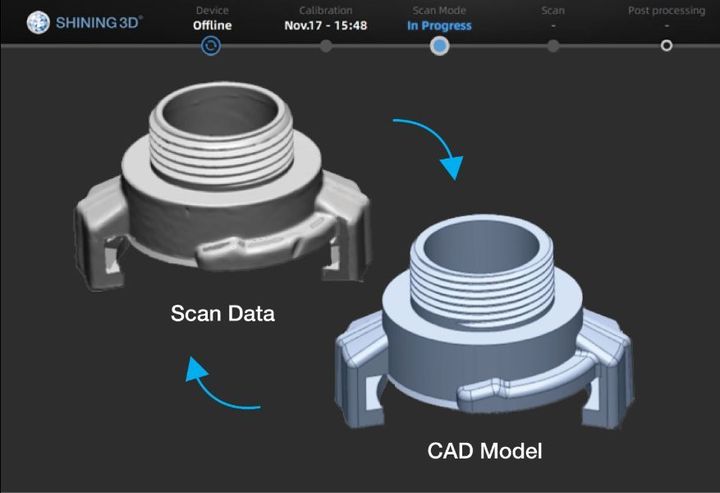
Shining 3D has launched a new reverse engineering service.
The company produces a number of products related to 3D printing, including a range of devices from desktop to industrializing DLMS and SLA processes. But they also produce a line of competent 3D scanners under the Einscan brand.
Their 3D scanning products can be obtained in both tabletop and handheld formats, and come with a variety of capabilities. The idea is for clients to choose the best option for the application.
While some 3D scanning work is intended to simply capture the geometry of a shape for virtual use, other applications instead want to capture the geometry for reproducing the part using 3D printing or other making means.
The problem when doing so is that the scans obtained are inevitably insufficient to do so directly: the surfaces wobble within the resolution of the 3D scanner, and that means they are not flat. There are other challenges, particularly when 3D scanning items that have moving parts: the scanner doesn’t recognize motion and thus you end up with a scan of a solid block rather than independent parts. In either case, it’s usually impractical to directly 3D print a 3D scan.
Reverse Engineering With 3D Scans
One way around these issues is to use a technique known as reverse engineering. In this process a 3D scan is obtained and is used as a base for developing a replacement 3D model in a CAD tool.
This can be attempted with most 3D CAD tools: you simply import the rough 3D scan as a mesh object, and then you gradually build replacement structures “on top” of the scan. It’s much like tracing a 2D image, except that you’re doing it in 3D with solid components. Once all the structures of the scan are recreated, you toss out the scan entirely and simply use the new 3D model created.
This sounds easy, but it isn’t, unless you have considerable CAD skills. While simple objects can be relatively easily recreated, other geometries involving complex curves, intersections and irregular shapes can be quite difficult to reproduce.
These challenges led some companies to develop specific “reverse engineering” CAD tools. These were essentially a 3D CAD system, but had extra tools to help with the reverse engineering process. For example, there could be ways to easily measure dimensions, or match a scanned curve.
That would seem to make things easier, except that you have to learn how to use the reverse engineering system, too! For those seeking to reverse engineer only a few parts, it may not be worth purchasing and learning yet another CAD tool.
Shining 3D Reverse Engineering
What should they do? Often this work is outsourced to freelancers, but now there seems to be another option for Einscan 3D scanner operators. Shining 3D says:
“We know that getting started in the 3D world can be challenging. This is why we have designed our 3D scanners as simple and easy-to-use yet delivering high end results for all kind of processing, design, engineering and manufacturing options. Getting into all of that at once can be quite hard sometimes and requires a thorough training and expertise for different devices and software. This is why we have launched our Reverse Engineering Service to help you get started or support you with your complicated projects. Our team of reverse engineering veterans is there to help you complete your project fast, efficiently and at a reasonable cost.”
And:
“This reverse engineering service is open for all 3D scanner users.”
Well then, that’s good news. I have a suspicion that many Einscan buyers are not capable reverse engineers and would benefit greatly from such an added service. The price of the Einscan equipment is low enough that they may attract first-time 3D scanning buyers who don’t yet realize the complexity they are getting into.
Shining 3D doesn’t publish prices for this service, as it obviously depends greatly on the nature of the project. They suggest contacting their sales department directly for a quote.
Via Einscan and Shining 3D
